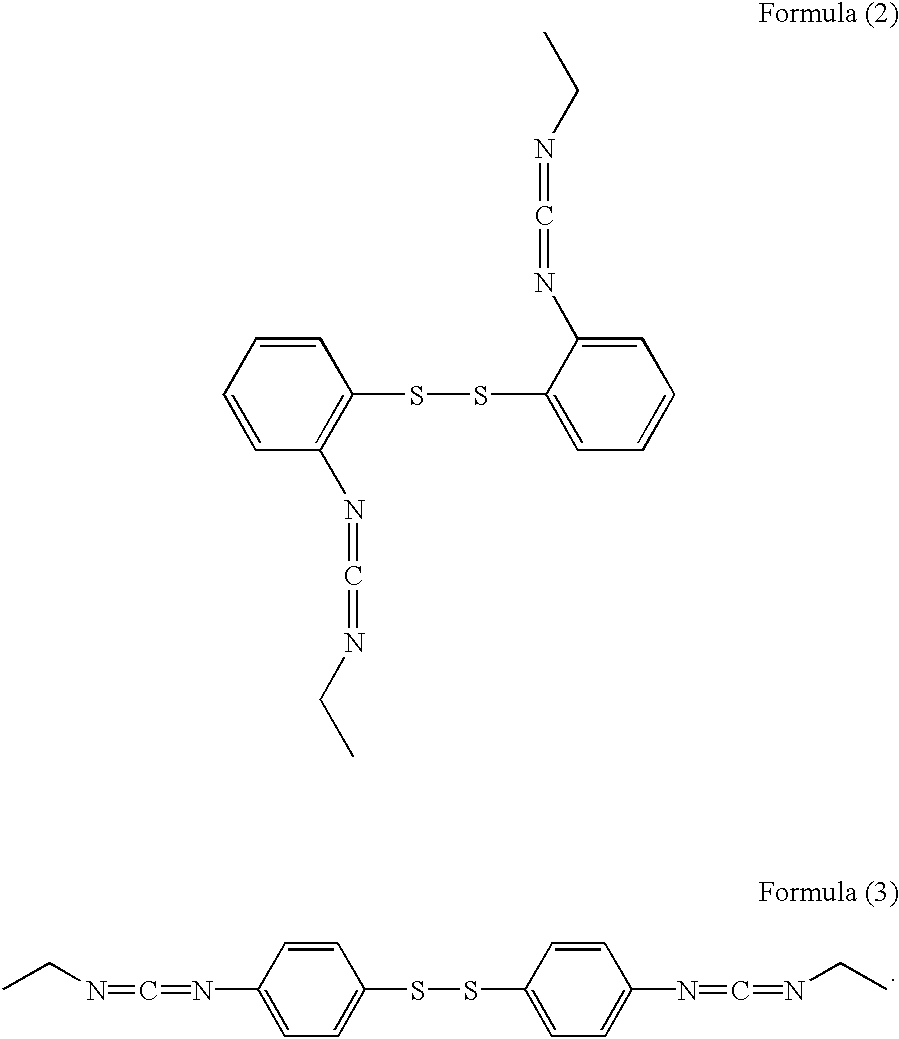Thiol- modified hyaluronan
a technology of hyaluronan and thiol, which is applied in the preparation of isocyanic acid derivatives, drug compositions, sugar derivates, etc., can solve the problems of damage to the optic nerve, increased occurrence of damaging side effects, and inability to readily clear cross-linked ha, so as to achieve more control of bioavailability and dosing. , the effect of not significantly reducing the activity
- Summary
- Abstract
- Description
- Claims
- Application Information
AI Technical Summary
Benefits of technology
Problems solved by technology
Method used
Image
Examples
example 1
Synthesis of the Masked Thiol-containing Biscarbodiimide of the Invention
[0126] To a solution of cystamine (2.826 g, 18.56mmol) in chloroform (15mL) was added dropwise ethyl isothiocyanate (2.05 mequiv, 3.235 g, 37.12 mmol) in chloroform (15mL). The solution was stirred for 4 hours, at which time a white precipitate formed. The precipitate was collected by filtration and washed with cold chloroform (3.times.5mL). The precipitate, 2,2'-dithiobis (N-ethyl (N'-ethylthiourea)), was dried under vacuum and used without further purification. To a solution of 2,2'-dithiobis(N-ethyl (N'-ethylthiourea)) (200 mg, 6.12 mmol) suspended in chloroform (8 mL) was added IN sodium hydroxide (2 mL) and sodium hypochlorite (10-13% available chlorine) (0.75 mnL). The two-phase system was shaken for 3 minutes and the chloroform layer isolated. The organic solvent was removed under reduced pressure to yield a yellow oil, 2,2'-dithiobis (N-ethyl (N'-ethylcarbodiimide)).
example 2
Cross-linking of High Molecular Weight Hyaluronan with 2,2'-dithiobis (N-ethyl(N'-ethylcarbodiimide))
[0127] Hyaluronic acid (600 mg, 1.5 mmol) was dissolved in distilled water (120 mL) and the pH adjusted to 4.75 using 0.1N HCl. 2,2'-dithio bis(N-ethyl(N-ethylcarbodiimide)) (116.3 mg, 0.45 mmol, 30 mol%) dissolved in acetone (58 mL, 2 mg / mL) was added. The pH was allowed to rise to 5.8, then gradually reduced back to 4.75 over a period of 3 hours, by dropwise addition of 0.1N HCl. The reaction mixture was made up to 5% NaCl (6 g) and stirred for 30 minutes at a room temperature of about 20.degree. C. The reaction mixture was poured onto ethanol (360 mL, 3 volume equivalents with respect to the aqueous volume). The precipitate was collected by filtration and dried under reduced pressure yielding 610 mg of product, a cross-linked hyaluronic acid derivative having an intramolecular disulfide bond.
example 3
Synthesis of 2,2'-dithiobis (N-ethyl(N'-ethylcarbodiimide)) - (BCDISS) via the Urea Route
[0128] a) Synthesis of 2,2'-dithiobis([N-ethyl(N'-ethylurea)) Intermediate
[0129] In a 50 mL round bottom flask, cystamine (1.0 g, 6.57 mmol) was dissolved in chloroform (30 mL). To the resulting solution was added in one aliquot, ethyl isocyanate (2.5 mequivs, 16.43 mmol, 1.167 g, 1.300 mL). The atmosphere was replaced with nitrogen; the flask was sealed; and the reaction was allowed to proceed for 16 hours. The chloroform was removed under reduced pressure, yielding a viscous oil. Methanol (20 ml) was added, and the oil scratched, yielding a white precipitate. The mixture was heated to dissolve the precipitate, then filtered. On cooling, a white crystalline powder formed, 2,2'-dithiobis (N-ethyl(N'-ethylurea)), which was separated and dried under high vacuum.
[0130] b) Synthesis of 2,2'-dithiobis (N-ethyl(N'-ethylcarbodiimide))
[0131] 2,2'-dithiobis (N-ethyl(N'-ethylthiourea)) (1.0 g, 3.06 mmol) ...
PUM
| Property | Measurement | Unit |
|---|---|---|
| Digital information | aaaaa | aaaaa |
| Digital information | aaaaa | aaaaa |
| Digital information | aaaaa | aaaaa |
Abstract
Description
Claims
Application Information
 Login to View More
Login to View More - R&D
- Intellectual Property
- Life Sciences
- Materials
- Tech Scout
- Unparalleled Data Quality
- Higher Quality Content
- 60% Fewer Hallucinations
Browse by: Latest US Patents, China's latest patents, Technical Efficacy Thesaurus, Application Domain, Technology Topic, Popular Technical Reports.
© 2025 PatSnap. All rights reserved.Legal|Privacy policy|Modern Slavery Act Transparency Statement|Sitemap|About US| Contact US: help@patsnap.com



